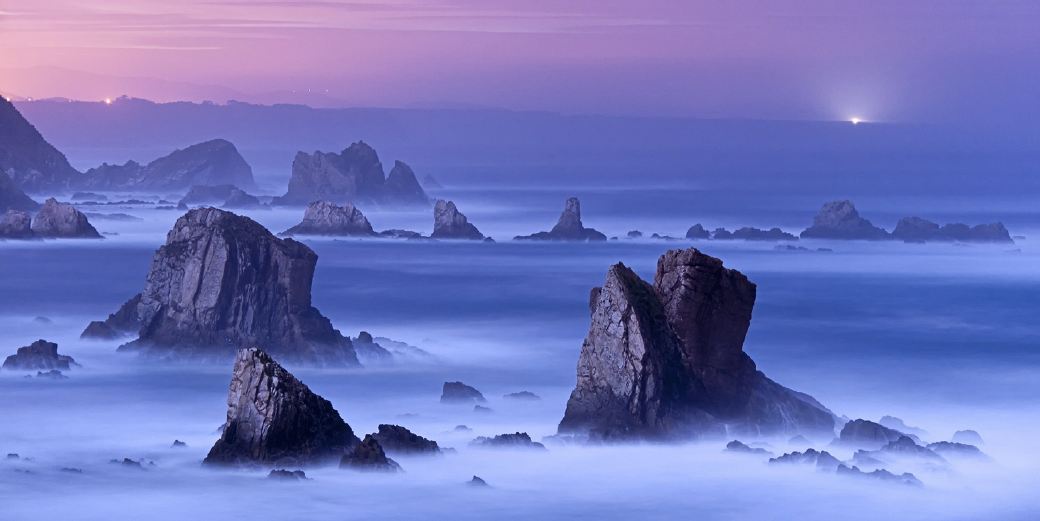The Problems
It’s dark! – Even cameras with an AF assist beam can rarely function at night. On a very moonlit night with a nice reflective subject with clear edges, the AF system may work, but its best not to bother.
I have read many Night Photography books stating that manual focus is the way to go, either at infinity, or hyperfocally.
I beg to differ, and suggest using your cameras AF system, but provide it something easy to focus on – then turn it off and avoid touching the focus ring. Problem solved.
Here’s how – The Solution
The easiest method is to focus on the moon, which is effectively at infinity, and this works fine if your image is a grand landscape with nothing too close to the front of the lens: In many wide angled images it can work just fine.
1 – Compose your shot to determine your required focal length.
2 – With AF ON – point the centre sensor at the moon, and focus.
3 – Turn off AF and recompose your shot.
A more reliable method however, giving the best depth of field is the AF – Hyperfocal method.
When you do your high ISO test shot, you know how much light you can play with. The variations of Aperture, Shutter Speed and ISO are creative choices we will look into soon, but for now, let us say for this example, you have decided on an Aperture of f4 @ 24mm
There are many Applications for DOF calculation available for Android, iPad/iPhone etc and they are invaluable in the field.
The Hyperfocal Distance on my camera at 24mm f4 is 4.8m
If I place a flashlight 4.8m from my camera and focus on it, then everything in my frame from 2.4m to Infinity should be sharp (assuming the camera is level to the plane of focus.)
Have a friend hold the light at the required focal distance and focus there and you will have sharp images across the maximum DOF for the given aperture.
This works great for focal lengths from 14-50mm above that your mate is having to head off into the distance quite some way!
NOTE – I would rather sacrifice half a meter of focus at the front and be assured of infinity focus. Adding a meter or two to the hyperfocal distance will achieve that result.
This method starts to break down some more when longer focal lengths are used, especially 200-300mm.
For these, I focus on infinity (moon or even Jupiter if you can see it) and then check the focus with a High ISO Test Shot.
If there are man made lights visible at a similar distance to your intended subject, focus on those. Using a High ISO test shot to check Exposure, if the shot is Level,
in Focus and a good Composition. They are VITAL to the success of your images. However, due to noise, exact focus can be difficult to judge at very high ISO.
By the time you invest 2 hours of exposure and perhaps 2 hours for Long-exposure Noise Reduction, that is a lot of time to waste if the image isn’t even sharp.
Even if your test shot is sharp, please be aware that any vibration from wind or even walking too near the tripod can result in shaking and blurred images. If its windy try to set your camera up in a sheltered spot behind some rocks or similar.
Incoming waves can also upset focus, as can the tripod settling into wet sand over time.
Once the exposure is being taken, keeping away from the camera is a good idea to avoid accidentally knocking it or causing unnecessary vibration.
What is Hyperfocal Distance?
Firstly, Hyperfocal Distance is not a fixed point, it is not constant and it changes between camera models, focal lengths of the lens used and the chosen aperture.
You need access to a DOF Calculator –
Iphone or Ipad App: http://www.bitwerkz.ch/f8.html
Android App: https://play.google.com/store/apps/details?id=in.zendroid.hyperfocal&hl=en_GB
The most simple definition is this – Hyperfocal Distance is the focal distance that allows everything from half that distance to infinity to be in focus.
For example – Nikon D3x – 24mm lens at f4 – Hyperfocal Distance = 4.8m
If I focus this Camera/Lens/Aperture combination at 4.8m (even at night) – I know that everything in the frame from 2.4m in front of the lens all the way to infinity should be in sharp focus.
The world is rarely flat and regular – I prefer to buy myself a couple of meters of flexibility and in the above case would rather focus at 6m and loose a little foreground in the frame (only 60cm less) – and be assured of infinity focus.
The stars really have to be sharp, and in many cases Infinity Focus on the moon works extremely well. This really is a matter of personal choice, hyperfocal or infinity focus.
At wide angles on full frame sensors I find the difference in DOF marginal. As you move up in focal length, the challenges of sharp foregrounds increase. Infinity focus however, always creates sharp stars, whereas trying to gauge a 50m hyperfocal distance @ 70mm can prove troublesome. Choosing your compositions with depth of field in mind though will enhance your shooting experiences and can open up quite dramatic scenarios.





